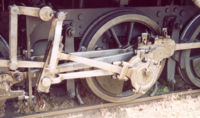Stephenson valve gear

The Stephenson valve gear or Stephenson link or shifting link is the oldest and simplest standard design of steam locomotive valve gear. The design is normally attributed to George Stephenson.
It is based on the eccentric rod valve gear developed for stationary steam engines, but with the added complexity that unlike a stationary steam engine, a steam locomotive needs to reverse. Stephenson gear uses two eccentric wheels and two eccentric rods, which both connect to a sliding link. This link may be raised and lowered by the hanger, which is in turn operated by the reversing rod. Raising and lowering the hanger connects one or the other of the eccentric arms to the valves, thereby selecting forward or reverse. Some later designs also used a single eccentric and eccentric arm. Stephenson gear is most commonly mounted internally, that is between the driving wheels, but this has the disadvantage of limiting the number of strengthening cross-braces that can be incorporated in the locomotive’s frame. However it is possible to mount the mechanism externally, similar to Walschaert gear.
History
Initially Stephenson’s gear provided no control of cutoff but in 1841 two employees in Stephenson’s locomotive works, draughtsman William Howe and pattern-maker William Williams, developed the design so that the driver could raise or lower the sliding link in small increments, using the reversing lever. This combined the motion from the “forward” and “back” eccentrics in differing proportions and thus controlled the travel of the valve rod.
The effect was to increase economy. Only at low speed and heavy load was steam fed to the cylinder during the entire power stroke; at higher speeds applying an early cutoff allowed a small amount steam to expand in the cylinder using its own energy, rather than continuing to draw from the boiler.
References
Snell, J B (1971). Mechanical Engineering: Railways, Longman & Co, London.
External links
- Diagram of standard Stephenson valve gear.
- Trouble shooting Stephenson valve gear, with diagrams.
